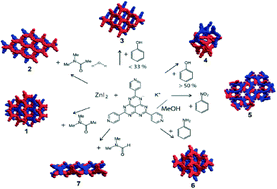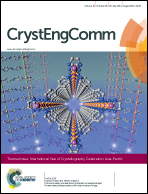The diversity of Zn(ii) coordination networks composed of multi-interactive ligand TPHAP−via weak intermolecular interaction†
Abstract
Kinetic state networks can be trapped by multi-interactive ligands via weak intermolecular interactions. Self-assembly of a tripyridyl multi-interactive ligand K+TPHAP− (potassium 2,5,8-tri(4′-pyridyl)-1,3,4,6,7,9-hexaazaphenalene) and ZnI2 produced seven types of networks depending on the solvent systems (MeOH/additive solvent): [ZnI(TPHAP)]·3.5CH3OH (1) (from MeOH/DMA), [ZnCl0.5I0.5(TPHAP)H2O]·7H2O (2) (from MeOH/DMA + water), [ZnI(TPHAP)]·3PhOH·2CH3OH (3) (from MeOH/phenol (< 33%)), [ZnI(TPHAP)]·5PhOH·2.5CH3OH (4) (from MeOH/phenol (>50%)), [ZnI(TPHAP)]·2PhNO2·6CH3OH (from MeOH/nitrobenzene) (5), [ZnI(TPHAP)CH3OH]·3PhNH2 (6) (from MeOH/aniline), and [(ZnI)2(TPHAP)(HCON(CH3)2)3(CH3OH)2]+[(ZnI2)2(TPHAP)(HCON(CH3)2)]− (HCON(CH3)2)·4CH3OH (7) (from MeOH/DMF). All structures were characterized by single crystal X-ray structure determination. Each topology was analyzed by TOPOS. The structures were categorized into two- or three-periodic structure. The structural features of each network were explained by the weak intermolecular interactions between TPHAP− and guest molecules. We demonstrated the multi-interactivity of TPHAP− which can recognize slight differences of the weak intermolecular interactions.

- This article is part of the themed collection: International Year of Crystallography Celebration: Asia-Pacific

 Please wait while we load your content...
Please wait while we load your content...